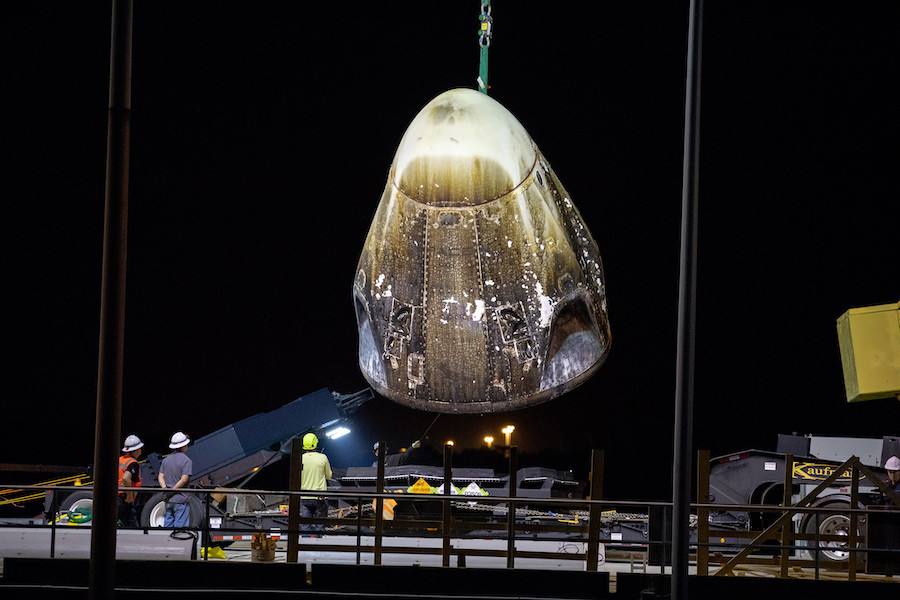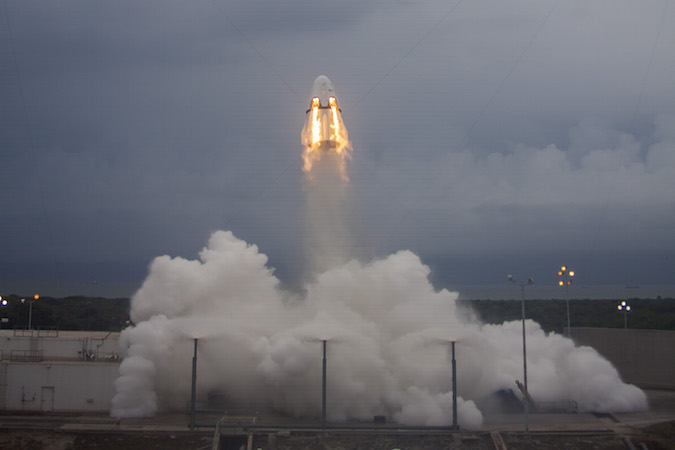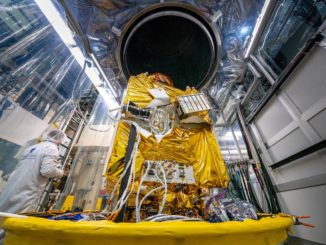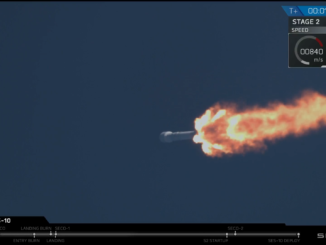
While recovery teams continue combing through the test site at Cape Canaveral where SpaceX’s first space-worthy Crew Dragon capsule was destroyed in an explosive accident last month, engineers a few miles away are pressing ahead with the company’s 17th resupply mission to the International Space Station set for launch early Friday.
SpaceX and NASA officials met Thursday and cleared a Dragon cargo capsule for launch from Cape Canaveral’s Complex 40 launch pad aboard a Falcon 9 rocket at 3:11 a.m. EDT (0711 GMT) Friday after data and hardware reviews to ensure the supply ship does not suffer the same fault that caused the explosion of a Crew Dragon spacecraft on a test stand April 20.
While the two vehicles share a name, the abort system that is the focus of the investigation into the Crew Dragon test accident does not fly on the Dragon spacecraft set to deliver nearly 5,500 pounds of supplies, experiments and provisions to the space station and its six-person crew.
The Crew Dragon was destroyed in a fiery accident about a half-second before the scheduled ignition of the spaceship’s SuperDraco abort engines during a hold-down firing at Cape Canaveral Air Force Station, a senior SpaceX official confirmed Thursday.
The update provided Thursday at the Kennedy Space Center by Hans Koenigsmann, SpaceX’s vice president of build and flight reliability, offered new details about the ground test accident, and was the first official confirmation that the spacecraft was destroyed in the explosion.
Koenigsmann said the accident occurred after successful test-firings of the ship’s Draco thrusters earlier in the day. The Crew Dragon, also known as the Dragon 2, has two sets of thrusters — the Dracos are used for in-orbit maneuvers, and are also used on the Dragon cargo ship, while the larger SuperDracos would activate during a launch emergency to boost astronauts away from a failing rocket.
“At the test stand, we powered up Dragon, it powered up as expected,” Koenigsmann said. “We completed tests with the Draco (maneuvering) thrusters, the smaller thrusters that are also on the cargo Dragon. We fired them in two sets, each for five seconds, and that went very well.
“And then just before we wanted to fire the SuperDraco, there was an anomaly, and the vehicle was destroyed,” Koenigsmann said. “There were no injuries. SpaceX had taken all safety measures prior to this test as we always do.”
Winds blew an acrid plume of red-orange toxic gas offshore from the test site at Cape Canaveral, located at SpaceX’s Landing Zone 1, where the company returns rocket boosters for propulsive landings.
The Crew Dragon vehicle lost in the test mishap was the same spacecraft that completed a successful six-day unpiloted test flight, known as Demo-1, to the International Space Station in early March, a mission that officials at the time said put SpaceX on course to fly a two-man team of NASA astronauts to the station later this year on the first human spaceflight to Earth orbit from U.S. soil since the end of the space shuttle program in 2011.

SpaceX is leading the investigation into the Crew Dragon accident, with the participation of NASA engineers.
NASA Administrator Jim Bridenstine told lawmakers Wednesday that NASA is investigating the Crew Dragon mishap “side-by-side” with SpaceX.
Responding to questions from Sen. Richard Shelby, R-Alabama, in a congressional hearing Wednesday, Bridenstine said he is confident engineers will determine the cause of the accident. When Shelby asked if NASA will conduct its own inquiry into the explosion, Bridenstine responded: “It is not strictly an independent investigation.”
“The engineers that we have at NASA are extremely sensitive to what we are trying to achieve, and they have an obligation to make sure that we are putting forth only the most accurate and precise data for the protection of our astronauts,” Bridenstine said. “I have every confidence that … as SpaceX conducts the investigation with our engineers, that we will get very accurate information as to what the anomaly was.”
NASA has awarded more than $3.1 billion in funding to SpaceX to develop the Crew Dragon spacecraft since the commercial crew initiative began in 2010. In a similar arrangement, the space agency has signed a series of commercial crew agreements and contracts with Boeing worth more than $4.8 billion over the same time period.
Boeing has also run into trouble during ground testing of abort engines on its CST-100 Starliner crew capsule.
The Starliner is scheduled for its first unpiloted demonstration flight to the space station in August, followed by a test flight with three astronauts on-board before the end of the year. The Starliner’s first missions were delayed to allow engineers to investigate and correct the cause of a fuel leak last year during a ground test-firing of the ship’s abort engines in New Mexico.
Boeing did not disclose the fuel leak, which held up the Starliner’s first flights by months, until weeks later, when the problem was first reported by Ars Technica.
It’s too soon to know how long last month’s Crew Dragon accident will delay SpaceX’s first mission with astronauts, officials said.
NASA astronauts Bob Behnken and Doug Hurley, both veterans of multiple space shuttle flights, are training to fly on the next Crew Dragon space mission.
“I believe what we learn from this test will make … Dragon 2, in the end, a better vehicle, a safer vehicle,” Koenigsmann said.
Once they complete their test programs, the Crew Dragon and Starliner capsules will begin ferrying four-person crews to and from the space station, ending NASA’s sole reliance on Russian Soyuz spacecraft for the job.
“In terms of schedule, I feel like finishing this investigation, resolving this anomaly, is actually our prime focus, for me right now,” he said. “We will see what comes out of it.”
Before the April 20 mishap, SpaceX and NASA expected the Crew Dragon’s next space mission — the first with astronauts on-board — could be ready for blastoff by late September or early October.
“I hope this is a relatively swift investigation at the end of the day, and I don’t want to completely preclude the current schedule,” Koenigsmann said. “It’s certainly not great news for the schedule overall, but I hope we can recover.”
SpaceX intended to fly the Crew Dragon spacecraft destroyed last month on a high-altitude abort test in July. The in-flight abort will be a dramatic demonstration of the SuperDraco engines’ ability to quickly ignite and propel the crew capsule away from a Falcon 9 rocket shortly after liftoff.
A prototype version of the Crew Dragon capsule completed an abort test from ground level in 2015 to prove the SuperDracos could push the craft away from an emergency on the launch pad and save its astronaut crew.
Koenigsmann said Thursday that the next Crew Dragon spacecraft under construction at SpaceX headquarters in Hawthorne, California, will be now used for the in-flight abort test. The next Crew Dragon out of the factory was previously assigned to the first mission with astronauts, designated Demo-2.
“We have started production, and we have several spacecraft in different shape and form right now, so we don’t (have to) turn around and build a new one now,” he said. “This is basically already in the works.”
Koenigsmann said investigators are sifting through telemetry data, high-speed imagery, and wreckage from the Crew Dragon capsule at Landing Zone 1, part of which remains off limits to investigators as recovery teams ensure hazardous materials, such as high-pressure tanks used in the spacecraft’s propulsion system.
“Because this (was a) ground test, we have a high amount of data, a huge amount of data from the vehicle and the ground sensors,” he said. “It is too early to confirm any cause, whether probable or root, but the initial data indicates the anomaly occurred during the activation of the SuperDraco system. That said, we’re looking at all possible issues and the investigation is ongoing.”

The Crew Dragon spacecraft has eight SuperDraco thrusters mounted around the circumference of the capsule in four pods. The SuperDracos each produce 16,000 pounds of thrust at full power, burning a mixture of caustic hydrazine and nitrogen tetroxide propellants, a combination commonly used in satellite propulsion because the two liquids ignite on contact.
The engines would be used to push the Crew Dragon capsule away from its Falcon 9 rocket in the event of an emergency during launch.
“We have no reason to believe there’s an issue with the SuperDracos themselves,” Koenigsmann said. “Those have been through about 600 tests at our test facility in Texas … We continue to have high confidence in that particular thruster.
“I do think it was not a SuperDraco thruster itself (that caused the accident), but that’s pretty much all I can say at this point in time,” he said.
Koenigsmann said the accident occurred during the activation sequence, around a half-second before the scheduled ignition.
“During activations, you pressurize the system, and you make sure everything is primed in,” he said. “You open valves, you close valves. That’s basically what an activation system does.”
While Koenigsmann stressed that the investigation into the Crew Dragon accident is still in its early stages, engineers from NASA and SpaceX were able to exonerate components on the crew capsule that are also used on the Dragon supply ship.
“We were able to get our arms around the common areas that we had to look at — that they had to look at — and at the end of the day, we didn’t see any change to our overall measurable risk (going into the Dragon cargo mission),” said Kenny Todd, NASA’s manager of space station operations and integration.
“I feel cargo Dragon is safe to fly to the station, and so is Falcon 9,” Koenigsmann said.
Assuming the Falcon 9 rocket lifts off early Friday — the weather forecast is iffy — the Dragon cargo ship is due to reach the space station Sunday.
Earlier this week, NASA asked SpaceX to delay the Dragon cargo launch two days to allow time for ground controllers to replace a failed electrical distribution box outside the orbiting complex, which provided a backup power supply to the station’s robotic arm.
Using the station’s Canadian-built Dextre robot, engineers at NASA’s mission control center in Houston completed the swap-out early Thursday.
After Dragon’s arrival and berthing to the space station’s Harmony module, the astronauts living aboard the will unpack several tons of food, provisions and experiments, then install research specimens for the Dragon capsule to return to Earth after its departure May 31.
Two experiment packages inside the Dragon’s unpressurized trunk will be robotically transferred to mounting posts outside the station.
One of them is a NASA instrument known as Orbiting Carbon Observatory-3, which will track changes in carbon dioxide levels in Earth’s atmosphere, the main contributor to climate change. Another instrument package containing multiple experiments sponsored by the U.S. military will also be delivered to the station.
The mission set for launch Friday will be SpaceX’s 17th resupply flight to the space station since 2012 under the auspices of a $3.04 billion cargo transportation contract with NASA covering 20 missions through early 2020. A follow-on resupply deal between SpaceX and NASA allows for at least six additional Dragon cargo flights through 2024.
The cargo contracts are separate from SpaceX’s commercial crew agreement with NASA.
Under the next cargo transportation contract, SpaceX plans to use a modified version of the Crew Dragon, or Dragon 2, spacecraft for logistics deliveries.
In the meantime, SpaceX plans to continue flying the first-generation Dragon, or Dragon 1, cargo capsule to complete the four remaining missions under the company’s first resupply contract with NASA, signed in 2008.
SpaceX ended production of the first-generation Dragon in 2017. Since then, the company has launched reused Dragon capsules that have already flown to the space station and returned to Earth with parachute-assisted splashdowns at sea.
The spacecraft schedule to lift off Friday first flew to the station in August 2017, on SpaceX’s 12th resupply mission.
Koenigsmann said the remaining three cargo missions purchased by NASA in the original 2008 contract will use Dragon vehicles making their third trips to the space station.
Email the author.
Follow Stephen Clark on Twitter: @StephenClark1.



